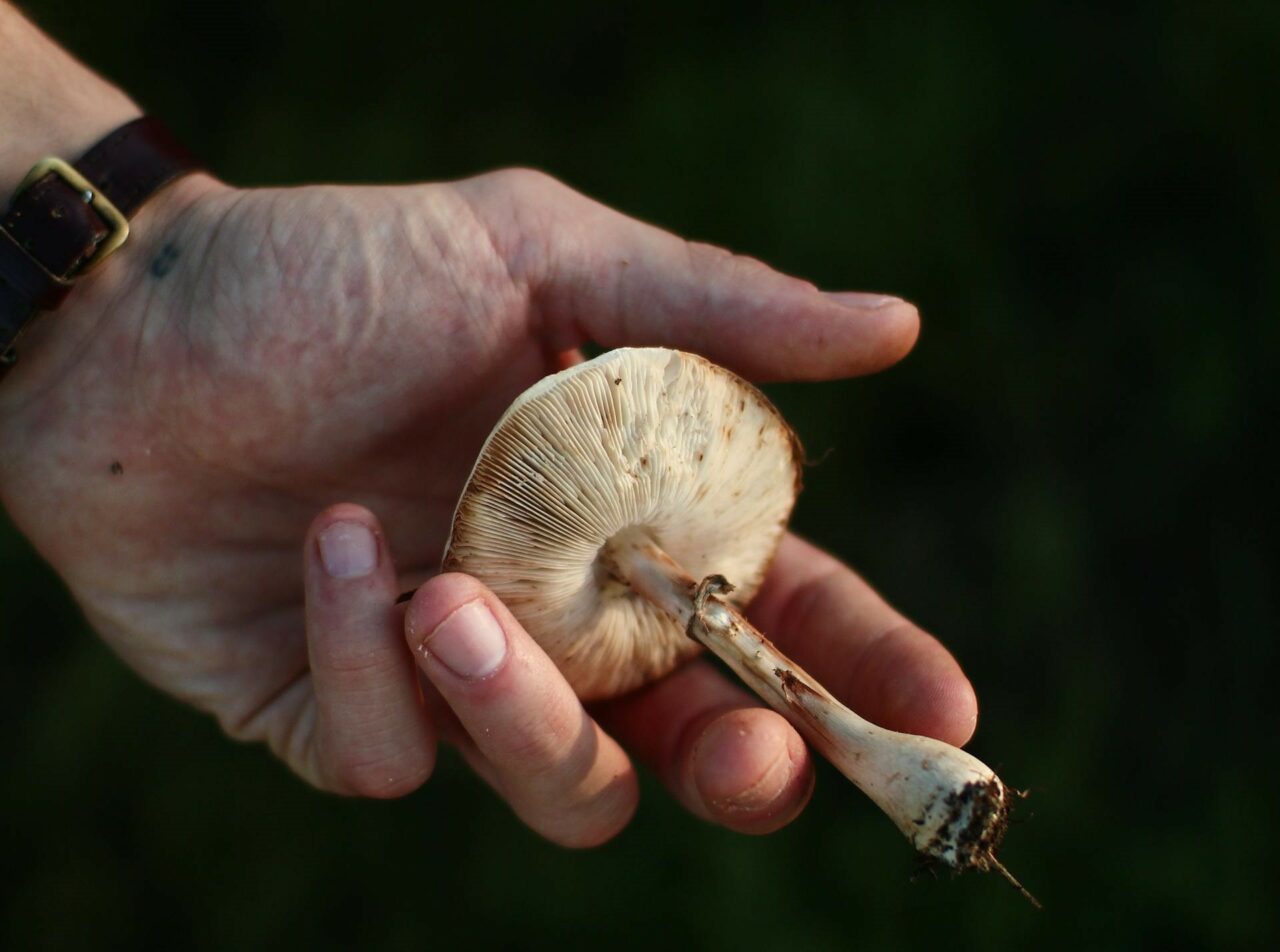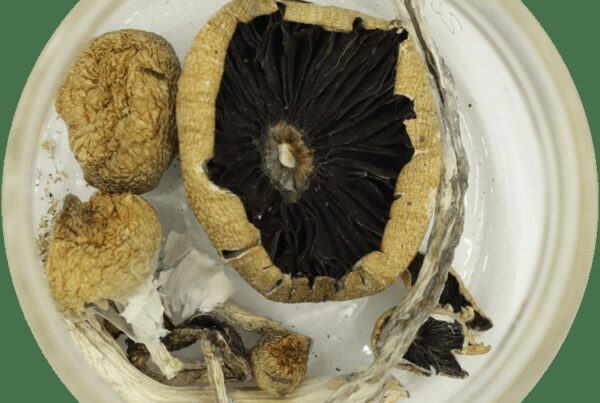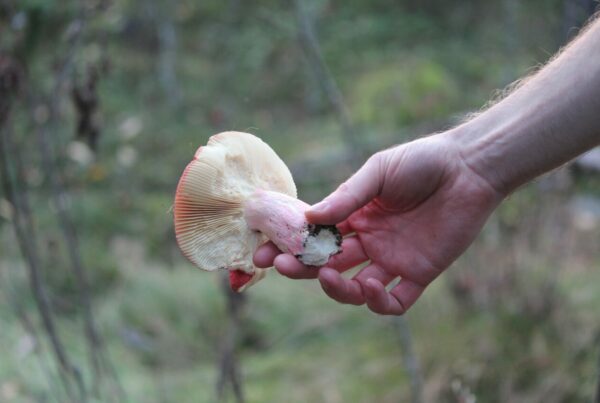Psilocybin mushrooms, akin to LSD in their role as a serotonin 5-HT2A receptor agonist, are a classic type of psychedelic. Presently, they are being explored in psilocybin-assisted therapies to treat various mental health issues such as major depression-related emotional distress, anxiety, cluster headaches, and migraines.
In order to understand how shrooms provide relief in these medical conditions, it’s essential to delve into how they are metabolized in the body. This knowledge helps both researchers and users ascertain the manner in which the active ingredient brings about psychological and therapeutic effects. This article offers a basic overview of the pharmacology and pharmacokinetics of psilocybin.
[toc]
Key Takeaways:
- Half of the psychedelic fungi ingested orally is absorbed and distributed throughout the body.
- The fungal compound is dephosphorylated by the enzyme alkaline phosphatase, mainly in the liver.
- About 3.4% of the compound is expelled in its unaltered form within 24 hours, while the rest is predominantly excreted as a stable metabolite.
What is Pharmacokinetics?
Pharmacokinetics (PK) is the scientific study of how substances like drugs are processed by the body once ingested. It is related to, but distinct from, pharmacodynamics, which focuses on how a compound interacts with the body. PK explores four primary areas: absorption, distribution, metabolism, and excretion (ADME).
Grasping these processes enables medical professionals to prescribe the most effective medications with the least potential for harm. Additionally, it allows them to customize treatments to suit each patient’s individual physiology and lifestyle.
How Does Pharmacokinetics Apply to Psilocybin?
The primary active compounds in certain types of magic mushrooms, psilocybin and psilocin, have piqued considerable curiosity among researchers and users. Pharmacokinetics studies how the body manages mushrooms containing psilocybin, aiding in understanding their potential medicinal or recreational effects.
These compounds, often referred to as “magic,” “psychedelic,” “medicinal,” or “sacred,” are found in certain fungi that are consumed. The Mushroom species, their place of origin, size, growth and drying conditions, and age can all greatly influence their potency levels.
While these mushrooms naturally occur in the wild, scientists have managed to replicate their growth in laboratory settings. Both naturally occurring and lab-grown mushrooms demonstrate low toxicity, though minor side effects like nausea or vomiting may occasionally present themselves.
Despite these potential side effects, the compounds present in these mushrooms have demonstrated potential therapeutic benefits due to their safety profile and non-addictive properties. This has led to ongoing research into their use in psychotherapy, specifically for the treatment of anxiety and depression.
The 4 Phases of Pharmacokinetics
Psilocybin, the active compound in these mushrooms, is initially inactive and functions as a prodrug, converting into its active form, psilocin. This conversion is aided by enzymes such as alkaline phosphatase, allowing for the absorption and circulation of psilocin throughout the body and to various tissues. However, following oral consumption, traces of psilocybin cannot be detected in the circulatory system, feces, or urine.
Absorption
Absorption refers to the process by which the compound enters the bloodstream from its site of administration. It plays a crucial role in determining the speed and effectiveness with which the compound reaches its intended target, like the plasma. Oral administration is the most common method, though inhalation has been explored, albeit with less effectiveness.
The process of absorption also encompasses the release of the compound from the dosage form during oral ingestion. Factors such as a delay in the throat or esophagus can affect this, potentially slowing down the effects or causing irritation. Once the compound reaches the stomach, the acidic environment may initiate its breakdown before it enters the bloodstream.
Research on animals indicates that only about half of orally administered psychedelics are absorbed and distributed throughout the body.
Factors Influencing the Absorption Process
There are several factors that can affect the absorption process, resulting in variations in the onset, intensity, and duration of the effects:
- Stomach Contents: The presence of food in the stomach can slow the absorption process, as it can delay the onset of effects. A faster absorption rate can be achieved on an empty stomach.
- Body Fat: Substances may accumulate in adipose tissues, potentially prolonging their effects.
- Age: Metabolic rates and body composition typically vary with age.
- Zero-Order Kinetics: The substance is eliminated at a constant rate, regardless of its concentration.
- First-Order Kinetics: The elimination rate is proportional to the concentration of the drug.
Several factors, such as the size, polarity, and protein-binding capacity of the product, along with an individual’s physiology—including hydration status and body makeup—significantly impact this process.
The goal is to achieve an effective concentration in the target area. For the product to be effective, it must reach its intended location, as determined by the volume of dispersion, and remain unbound to proteins, allowing it to interact actively with its receptor.
What Factors Affect the Dispersion Process?
Several factors can influence the dispersion process:
Effects generally begin to emerge within 20-40 minutes after ingestion, peaking approximately 80-100 minutes in. The effects of magic mushrooms usually endure for a time span of 4-6 hours.
How Does Dispersion to the Brain Happen?
An initial experimental study conducted on two species demonstrated that the order of its binding affinity is 5HT2A > 5HT1A > 5HT2B [23]. It also attaches to dopamine D1, 5HT1E, 5HT5A, 5HT7, 5HT6, D3, 5HT2C, and 5HT1B receptors.
It acts as a partial agonist at the 5HT2A receptor, with an efficacy of roughly 40%. The psychedelic effects can be tied to its partial agonist activity at 5HT1A autoreceptors.
The mood-lifting and psychotomimetic experiences may be linked to the observed correlation between increased dopamine levels and feelings of depersonalization and ecstasy. Hallucinogens work by modifying neurochemistry and receptor activity. It enhances 5HT2A agonist activity by boosting BDNF synthesis in the hippocampus, which in turn encourages neurogenesis and lessens conditioned fear-related behaviors.
Elimination
Elimination refers to the process by which the The body discharges a substance mainly through the kidneys, but also through the lungs, skin, or gastrointestinal tract. Concerning the kidneys, a naturally occurring psychedelic substance is filtered at the glomerulus or secreted in the tubules, with some reabsorption contributing to the complexity of the process.
The primary substance has a half-life of roughly 160 minutes, whereas psilocin’s half-life is about 50 minutes. Animal studies have demonstrated that this is primarily excreted in the urine, comprising about 65% within 8 hours of consumption. Traces of the substance can still be detected in smaller amounts in bile and feces.
In human bodies, about 3.4% of the substance is expelled in its unaltered form within a day, while the majority is eliminated as psilocin-O-glucuronide, a more stable metabolite. This stability allows the substance to be identifiable in urine samples over a prolonged period.
Substance elimination occurs via two primary methods:
Most psychedelic substances follow the first-order kinetics method, reaching stable concentrations after four to five half-lives. Complete removal also occurs after approximately four to five half-lives.
Discover Our Range of Hallucinogenic Mushrooms
The metabolic process varies across different mushroom species. By choosing trusted online vendors like Magic Mushrooms Vancouver Canada, you can steer clear of potentially poisonous mushrooms. Certain types, such as Agaric mushrooms, can induce strong and undesirable effects. Hence, it’s vital to obtain magic mushrooms from reliable sources, avoiding risky street vendors or wild foraging.
| Feature | Enigma | Full Moon Party | Gold Member | |
| Strain Type | Psilocybe Cubensis OMNI | Psilocybe cubensis (Thai Koh Samui) | Psilocybe cubensis | |
| Potency | Exceptionally high; 3.8% tryptamine content | Moderate to high potency | High potency | |
| Visual Characteristics | Resembles a blob or | Resembling a cauliflower or brain | Exhibits classic cubensis features; of moderate size | Robust white stalks; caps with a golden caramel hue; distinctly blue when bruised |
| Effects | Considered the most potent; generates intense effects | Produces a potent cerebral high; onset is delayed but visuals are pronounced | Induces strong visuals and euphoria |
Educate Yourself on Psilocybin Mushroom Use Online
For medical professionals, researchers, and users, a firm grasp of shroom pharmacokinetics is essential. Equipped with this knowledge, you can make educated decisions about dosage and timing, thereby reducing potential hazards.
Discover your perfect psychedelic experience at Magic Mushrooms Vancouver Canada. Regardless of whether you’re in search of a soothing journey or a more profound exploration, our wide range of products is designed to meet your unique requirements. We offer top-notch, safe, and quality-assured shrooms, eliminating worries about unreliable sources or poisonous mushrooms.
Sample the best magic mushrooms Canada provides and take your psychedelic exploration to unparalleled heights.
Frequently Asked Questions
Are there any known interactions between shrooms and other drugs?
Our products may interact with certain medications, particularly those that affect serotonin levels like SSRIs (Selective Serotonin Reuptake Inhibitors). SSRIs and SNRIs (Serotonin and Norepinephrine Reuptake Inhibitors) generally reduce the effects, unlike non-serotonergic antidepressants. This reduced effect can last for up to three months after stopping the use of antidepressants.
Do all psychedelics operate similarly to psilocybin?
No, each psychedelic compound has a unique structure that requires different metabolic processes to activate, and they attach to various receptors in the body. The way it is administered also affects the absorption of each psychedelic. While the basic principles of absorption, metabolism, and distribution stay the same, the specific pathways and effects vary for each substance.
Does the form of the shroom affect its pharmacokinetics?
Yes, the form (such as fresh, powdered, or dried mushrooms) can impact absorption rates. For example, powdered forms might be absorbed faster than whole dried ones due to their quicker dissolution.
Further Reading:





